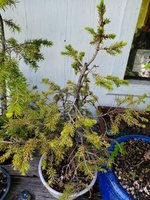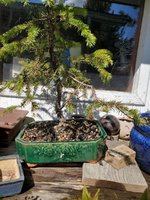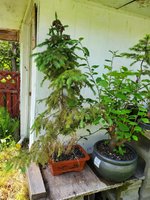BillsBayou
Chumono
"I wouldn't have minded, but it kept pushing the Popcorn setting."I had a port growing once near my microwave and after years of radiation exposure it became sentient. I will never mess with plant DNA again.
"I wouldn't have minded, but it kept pushing the Popcorn setting."I had a port growing once near my microwave and after years of radiation exposure it became sentient. I will never mess with plant DNA again.
All I need is one.I would venture that most bonsai hobbiests do not have the education nor the access to the equipment and facilities necessary to conduct such experiments properly.
I am awaiting your "gain of function" research so I can get "Self pruning and self wiring" bonsai.I think you're talking about selective cross-breeding. With your method, you'd wait for the seedlings to mature and cross pollinate them. Faster results may come from collecting flowers from trees in one region and using the pollen on flowers in another region. Changes in morphology are typically within expected results.
Mutagenics, however, involves soaking the seeds in various concentrations of DNA-altering compounds. The mutations are graded against desired results. Then the selected plants are either tested to see if the mutations carry on through generations or cuttings are propagated to maintain the mutation. Changes in morphology using mutagenic compounds are random and sometimes outside the results you can get with cross-breeding.
Thank you for the feedback. This is the sort of answer I was hoping to get. The chances of me changing "something" are near zero. Of that group, changing something I'd recognize is near zero. Of THAT group, changing something I want to change is so damned close to zero it is indistinguishable from zero. Chance of developing something bad in MY genome: Likely.I can get discounts on whole genome sequencing if anyone's interested.
But generally speaking, I'm the guy.
I know about mutagenic compounds, I know genetics to some extent (because I work in that field) and I've worked at the second largest breeding Evilcorp in the world. I even got to meet one Dr. Evil himself.
I also have explained this to IT guys a couple times..
In a random mutagenic setting, where something is applied and we want a certain result.. Chances to hit a 1200 basepair gene, in a 120Gb genome, is small. 1200 bytes out of 120 million.
That being said, it's possible. But we'd have to account for damage repair, double chromosome sets, ploidy, methylation and so forth.
Think about 1 in 17000 every try.
Without knowing the area of interest, the part that you want to target, or in laymans terms: the software you want to modify.. It'll be a crapshoot. Compare it to giving a bunch of keyboards connected to a linux pc to monkeys and waiting until one of them types a perfect piece of code that prints Hello World.
Now imagine there's also a program running in the background that does random shutdowns AND erases inputs and replaces it with just 1's and 0's.
But all is not lost. I can tell you that there are people looking into cork production in cork oaks and trying to zone down on the region of interest. But they're also not making a whole lot of progress.
What you can try is heat stressing a couple cell cultures (45 degrees C for various times), grow plants out of those and hope for the best. Seeds can be used for this too.
Also, mutagenic compounds are easy to get but they're dangerous - like stupidly dangerous, the Dr. Evil I met couldn't control a single muscle in his body - and you'd have to work with super large numbers. Think thousands of seedlings at a time. Just the space and operation will cost you about 30K a month for a single employee. With no guarantees. If you have that kind of money, I'm game.
But the hard part is getting a return of that investment.. Because for ornamental plants, there is none.
Let's just say it's cheaper and easier to get yeast to produce cocaine (because yeast can easily take up foreign genes), than it is to get a plant to mutate.
That doesn't mean you shouldn't try. But a realistic idea of what you can expect is always a good thing. Those people finding random mutations are super lucky.
When we're talking about foliage size, that stuff is all over the literature. You can probably find entire protocols on how to treat your plants and it's a matter of finding the right concentration and timing. With more elusive stuff like cork bark, or foliar fingers on maples, it's an entirely different game because we simply don't know which genes to target. Imagine having to compare 120 Terabytes of data times 40 sets, within a reasonable time span and then ruling out 70gb of possible target genes consisting out of 10000 basepairs each. It might just be a single point mutation, which means that you're looking for a single 1 or 0 in 70gb of data. Without a proper sample size, and serious computing power, that's a no go.
One whole genome assembly (that's the starting point) is about 800-1200 dollars. You'd need about 50 of a model organism without the mutation, and another 4 to 12 from one with the mutation.
I'm much better off hunting out mutations in the forests and swamps around my home.
This.I am awaiting your "gain of function" research so I can get "Self pruning and self wiring" bonsai.
I'm in no hurry to get self pruning and self wiring tree. I'm too busy strokin' my BC @Sekibonsai style.This.
I happen to have self-pruning trees already. Forget to water them or take them off the benches in a cold snap? The trees drop limbs as a way of punishing me.
As for self-wiring trees, there is a wisteria in the neighbor's yard that creeps over the fence, races around my trees, and leaves wire scars on trees I've never wired.
You can keep your self-pruning and self-wiring trees.
Oh no, the chances of you changing something is a 100%. That's easy. Just withold nutrients all together and notice a serious reduction in size. Manage to do that for a couple generations and nothing will ever grow large.Thank you for the feedback. This is the sort of answer I was hoping to get. The chances of me changing "something" are near zero. Of that group, changing something I'd recognize is near zero. Of THAT group, changing something I want to change is so damned close to zero it is indistinguishable from zero. Chance of developing something bad in MY genome: Likely.
I'm much better off hunting out mutations in the forests and swamps around my home.
I need you to give us all a seminar.Oh no, the chances of you changing something is a 100%. That's easy. Just withold nutrients all together and notice a serious reduction in size. Manage to do that for a couple generations and nothing will ever grow large.
For dwarfing this mechanism is known and can be induced chemically in a single generation. I've done it by accident a couple times.
But for the less known stuff, stuff that nobody has researched and stuff that nobody ever induced by accident, it's pretty difficult without a serious genome study. Mostly because the species we use for bonsai are barely researched by geneticists. They look into wood production, fire resistance, disease resistance and stuff that's economically viable. But rarely into something like fall colors or corking bark.
It'd be faster to hybridize. And that is something I could help you with. Something we could do for pennies and in a reasonable timespan.
Atomic gardening is a form of mutation breeding where plants are exposed to radioactive sources, typically cobalt-60,[1] in order to generate mutations, some of which have turned out to be useful.
The practice of plant irradiation has resulted in the development of over 2000 new varieties of plants, most of which are now used in agricultural production.[2] One example is the resistance to verticillium wilt of the "Todd's Mitcham"[3] cultivar of peppermint, which was produced from a breeding and test program at Brookhaven National Laboratory from the mid-1950s. Additionally, the Rio Star Grapefruit, developed at the Texas A&M Citrus Center in the 1970s, now accounts for over three quarters of the grapefruit produced in Texas.[4]

I might take you up on that. Because I'm seriously curious about pine cork bark genetics.I need you to give us all a seminar.
Hey we can join in and do coop researches for repeatabilityI might take you up on that. Because I'm seriously curious about pine cork bark genetics.
The thing is that I suck with JBP. If someone would ever find a scots pine with cork bark, I'd be able to run a couple breeding projects and have valuable data. My JBP's rarely last more than 3 years.. Which isn't even enough to produce pollen. But what I can do, is provide all the know how and techniques to produce a cork bark JRP, so that I too can have a corking pine. And maybe even get cork bark JBP from seeds instead of cuttings.
It's simple mendellian genetics and it would take a couple years.. But it can be done in a reasonable time frame of 10-15 years and a couple meters of garden space.
For elms and maples, that might be a different story. Think 3-8 years.
One whole genome assembly (that's the starting point) is about 800-1200 dollars. You'd need about 50 of a model organism without the mutation, and another 4 to 12 from one with the mutation.
I might take you up on that. Because I'm seriously curious about pine cork bark genetics.
The thing is that I suck with JBP. If someone would ever find a scots pine with cork bark, I'd be able to run a couple breeding projects and have valuable data. My JBP's rarely last more than 3 years.. Which isn't even enough to produce pollen. But what I can do, is provide all the know how and techniques to produce a cork bark JRP, so that I too can have a corking pine. And maybe even get cork bark JBP from seeds instead of cuttings.
It's simple mendellian genetics and it would take a couple years.. But it can be done in a reasonable time frame of 10-15 years and a couple meters of garden space.
For elms and maples, that might be a different story. Think 3-8 years.



I like to look around all the old mines in the area, in the tailings piles especially. If it can survive in coal laden dust and clay, there's only so much that can kill it.I Just plant MANY... wait for natural mutants..
Maybe I should collect seeds from the Nuclear Facilities Property.
